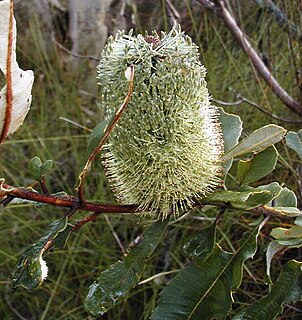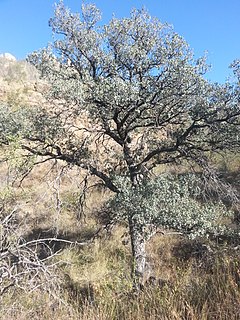
Alnus incana, the grey alder or speckled alder, is a species of tree in the birch family, with a wide range across the cooler parts of the Northern Hemisphere.

Banksia oblongifolia, commonly known as the fern-leaved, dwarf or rusty banksia, is a species in the plant genus Banksia. Found along the eastern coast of Australia from Wollongong, New South Wales in the south to Rockhampton, Queensland in the north, it generally grows in sandy soils in heath, open forest or swamp margins and wet areas. A many-stemmed shrub up to 3 m (9.8 ft) high, it has leathery serrated leaves and rusty-coloured new growth. The yellow flower spikes, known as inflorescences, most commonly appear in autumn and early winter. Up to 80 follicles, or seed pods, develop on the spikes after flowering. Banksia oblongifolia resprouts from its woody lignotuber after bushfires, and the seed pods open and release seed when burnt, the seed germinating and growing on burnt ground. Some plants grow between fires from seed shed spontaneously.

Alnus oblongifolia is a large alder, birch-family tree up to 72 feet (22 m), from the southwestern United States and northern Sonora, Mexico. It grows across Arizona into western New Mexico mountain ranges. In central Arizona its range extends across the transition zone to the White Mountains region of eastern Arizona–western New Mexico border.
Burmeistera oblongifolia is a species of plant in the family Campanulaceae. It is endemic to Ecuador. Its natural habitat is subtropical or tropical moist montane forests.
Syzygium maingayi is a species of plant in the family Myrtaceae. It is found in Malaysia and Singapore.
Helicia albiflora is a species of plant in the family Proteaceae. It is endemic to Papua New Guinea. It is threatened by habitat loss.
Helicia calocoma is a species of plant in the family Proteaceae. It is endemic to Papua New Guinea. It is threatened by habitat loss.
Helicia insularis is a species of plant in the family Proteaceae. It is endemic to Papua New Guinea. It is threatened by habitat loss.
Helicia latifolia is a species of plant in the family Proteaceae. It is endemic to Papua New Guinea. It is threatened by habitat loss.
Helicia peltata is a species of plant in the family Proteaceae. It is endemic to Papua New Guinea. It is threatened by habitat loss.
Hopea oblongifolia is a species of plant in the family Dipterocarpaceae. It is found in Myanmar and Thailand.
Knema oblongifolia is a species of plant in the family Myristicaceae. It is a tree endemic to Peninsular Malaysia. It is threatened by habitat loss.
Madhuca oblongifolia is a species of plant in the family Sapotaceae. It is endemic to the Philippines. It is threatened by habitat loss.
Naucleopsis chiguila is a species of plant in the family Moraceae. It is endemic to Ecuador.
Naucleopsis is a plant genus in family Moraceae.
Pitcairnia oblongifolia is a species of plant in the family Bromeliaceae. It is endemic to Ecuador. Its natural habitat is subtropical or tropical dry forests. It is threatened by habitat loss.

Sarcolaena oblongifolia is a species of plant in the Sarcolaenaceae family. It is endemic to Madagascar. Its natural habitats are subtropical or tropical moist lowland forests and subtropical or tropical moist shrubland. It is threatened by habitat loss.
Shorea oblongifolia is a species of plant in the family Dipterocarpaceae. It is endemic to Sri Lanka.

Quercus oblongifolia, commonly known as the Arizona blue oak, Blue live oak or Sonoran blue oak, is an evergreen small tree or large shrub in the white oak group.
Clermontia oblongifolia is a species of flowering plant in the bellflower family known by the common name Oahu clermontia. It is one of several Hawaiian lobelioids in genus Clermontia that are known as ʻoha wai. This plant is native to three of the Hawaiian Islands, where one subspecies is not uncommon but the other two are very rare and endangered.





